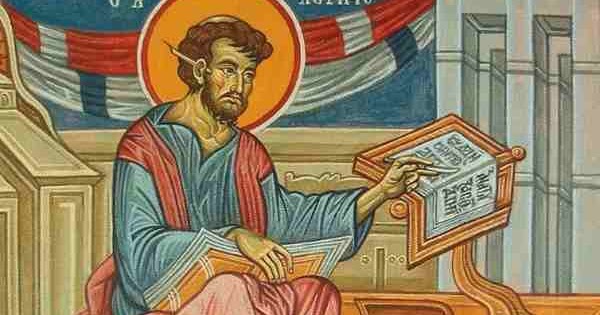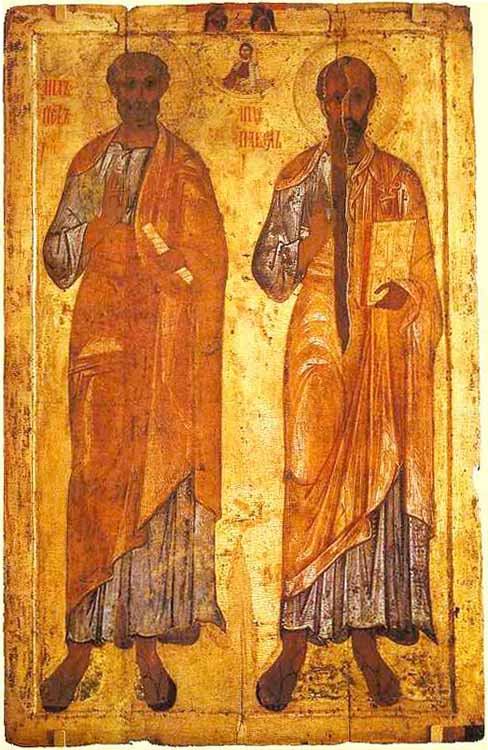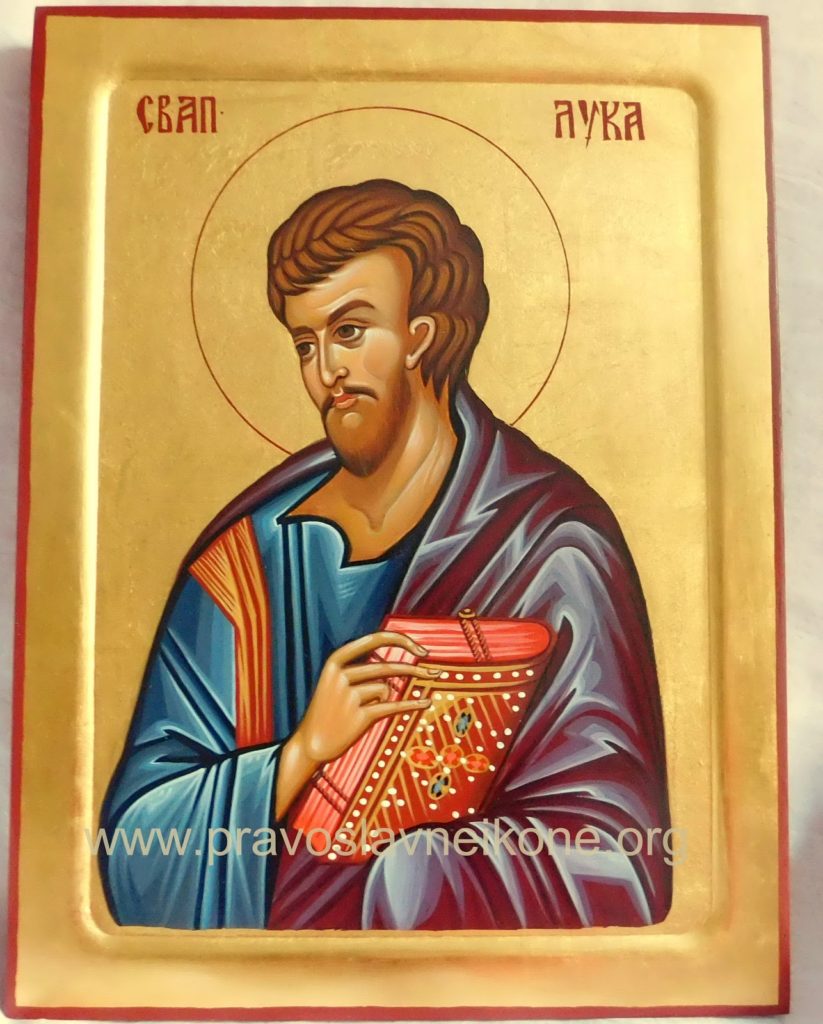Saint Luke the Evangelist was a native of Antioch in Syria. In his youth, he studied Greek philosophy, medicine and iconography well. He was fluent in Egyptian and Greek. During the activity of the Lord Jesus on earth, Luke came from Antioch to Jerusalem. Living as a man among men, the Lord Jesus sowed the divine seed of his saving teaching, and Luke’s heart would be a good earth for that heavenly seed. And it sprouted in him, sprouted and brought forth a hundredfold fruit.
For Luke, looking the Savior face to face and listening to His divine teaching, was filled with divine wisdom and divine knowledge, which neither the Hellenic nor the Egyptian schools gave him: he knew the true God, believed in Him, and was included in the Seventy Apostles, and sent to preach. He himself speaks about this in his Gospel: After this, the Lord appointed seventy-two others and sent them two by two ahead of him to every town and place where he was about to go.(Luke 10: 1).
And St. Luke, armed by the Lord with the power and authority to preach the Gospel and perform miracles, walked “before the face” of the Lord Jesus Christ, preaching the holy sermon, preparing the way for the Lord and convincing people that the expected Messiah had come into the world.
After the descent of the Holy Spirit on the apostles, St. Luke stayed for a while with the other apostles in Jerusalem, and then went to Antioch, where there were already many Christians. On that journey, he stayed in Sebastia, preaching the Gospel of salvation. The incorruptible relics of St. John the Baptist rested in Sebastia.
Starting from Sebastia, Saint Luke wanted to take those holy relics and transfer them to Antioch, but the Christians there did not want to be left without such a precious shrine. Later they allowed it, and St. Luke took the right hand of the holy Baptist, under which the Lord bowed His Divine Head at John’s baptism. With such a precious treasure, Saint Luke arrives in his homeland, to the great joy of the Antiochian Christians.
Saint Luke left Antioch only when he became a collaborator and companion of the holy apostle Paul. This happened during the Second Journey of St. Paul. Then St. Luke traveled with the Apostle Paul to Greece to preach the Gospel. Saint Paul left Saint Luke in the Macedonian city of Philippi, to establish and arrange the Church there. From that time, St. Luke remained in Macedonia for several years (Acts 20: 6), preaching and spreading Christianity.
When St. Paul visited Philippi again at the end of his Third Apostolic Journey, he sent St. Luke to Corinth to collect alms for the poor Christians in Palestine. Having collected alms, St. Luke and the holy apostle set out for Palestine, visiting the Churches along the way, which were located on the islands of the Archipelago, on the shores of Asia Minor, in Phenicia and Judea.
And when the apostle Paul was placed under guard in the Palestinian city of Caesarea, St. Luke remained beside him. He did not leave the apostle Paul even when he was sent to Rome, to the court of Caesar. Together with the Apostle Paul, he endured all the hardships of traveling by sea, exposing himself to great dangers (cf. D. A. 27 and 28 chapters).
Arriving in Rome, St. Luke was also next to the Apostle Paul, and together with Mark, Aristarchus and some other companions of the great apostle- the people, he preached Christ in that old capital. In Rome, St. Luke wrote his Gospel and the Acts of the Holy Apostles. In the Gospel, he describes the life and work of the Lord Jesus Christ not only on the basis of what he himself saw and heard, but also having in mind everything that was handed down by “the first eyewitnesses and servants of the word.” (Luke 1: 2). In this holy work, St. Luke was led by the Holy Apostle Paul, who then approved the Holy Gospel written by St. Luke. Likewise, according to church tradition, the Acts of the Holy Apostles were written by St. Luke on the orders of the Holy Apostle Paul.

After two years of imprisonment in Roman captivity, the Holy Apostle Paul was released, and leaving Rome he visited some of the Churches he had founded earlier. On this journey, St. Luke followed him. Not much time passed and Emperor Nero raised a fierce persecution of Christians in Rome. At that time, the apostle Paul arrived in Rome for the second time, in order to encourage and support the persecuted Church with his word and example.
But the Gentiles seized him and threw him into chains. Even in this difficult time, Saint Luke was incessantly next to his teacher. The Holy Apostle Paul writes about himself as a sacrifice that is already on the altar. I am already becoming a victim, the holy apostle wrote to his disciple Timothy at that time, and the time of my departure came. Make sure you come to me quickly; for Dimas left me, having loved his present world, and went to Thessalonica; Kriskent in Galatia, Titus in Dalmatia; Luke is alone with me (2 Tim. 4: 6, 10).
It is very probable that St. Luke was an eyewitness to the martyrdom of St. Paul the Apostle in Rome. After the martyrdom of the Apostle Paul, St. Luke preached about the Lord Christ in Italy, Dalmatia, Gaul, and especially in Macedonia, where he had worked for several years before. In addition, he preached about the Lord Christ in Achaia.
In his old age, Saint Luke traveled to Egypt to preach the Gospel. There, while preaching about Christ, he suffered many hardships and performed many feats. And he enlightened distant Tivaida with the eternal light of the Gospel of Christ. In the city of Alexandria, he ordained Bishop Avila to replace Anianus, who was ordained by the holy evangelist Mark. Returning to Greece, St. Luke organized the Church, especially in Boeotia, ordained priests and deacons, and healed many sick people’s bodies and souls.
Saint Luke was eighty-four years old, when evil idolaters tortured him for Christ’s sake and hanged him on an olive tree in the city of Thebes in Boeotia. His honorable body would be buried in Thebes, the capital of Boeotia, where many miracles were performed by it. These holy miraculous relics were located there until the second half of the fourth century, when they were transferred to Constantinople, in the time of Emperor Constantius, son of Constantine.
In the fourth century, the place where the relics of Saint Luke rested became especially famous, because of the healings that took place from them. Especially healing from eye diseases. Upon learning of this, the emperor Constantius sent the governor of Egypt, Artemis, to transfer the relics of St. Luke to the capital, which would be done very solemnly.
At the time of the transfer of these holy relics from the seashore to the holy temple, a miracle like this happened: An eunuch of Anatolia, while serving in the royal court, was ill for a long time from an incurable disease. He spent a lot of money on doctors, but did not receive healing. And when he heard that the holy relics of Saint Luke were being brought into the city, he began to pray with all his heart to the holy apostle and evangelist for healing. As soon as he got out of bed, he ordered them to take him to meet the coffin with the relics of St. Luke.
And when they brought him to the coffin, he bowed to the holy relics and touched the coffin with faith, and at that moment he received complete healing and became perfectly healthy. And immediately he put his shoulders under the coffin with the holy relics, and carried it with the other people, and brought it into the temple of the holy Apostles, where the relics of St. Luke were placed under the holy throne, next to the relics of the holy apostles: Andrew and Timothy.
Old church writers say that St. Luke, responding to the pious wish of the local Christians, was the first to paint the icon of the Most Holy Mother of God with the Infant Lord Jesus on her hands, not one but three, and brought them to the Mother of God. Looking at them, she said: The grace of the One born of me, and mine, may they be with these icons.

Saint Luke also painted on the boards the icons of the holy supreme apostles Peter and Paul. And so the holy apostle and evangelist Luke set the beginning of a wonderful and God-pleasing work – painting the holy icons, to the glory of God, the Mother of God and all the Saints, and to the beauties of the holy churches, and to the salvation of the faithful who reverently revere the holy icons. Amen.


